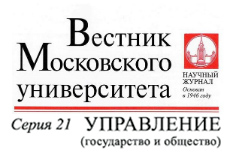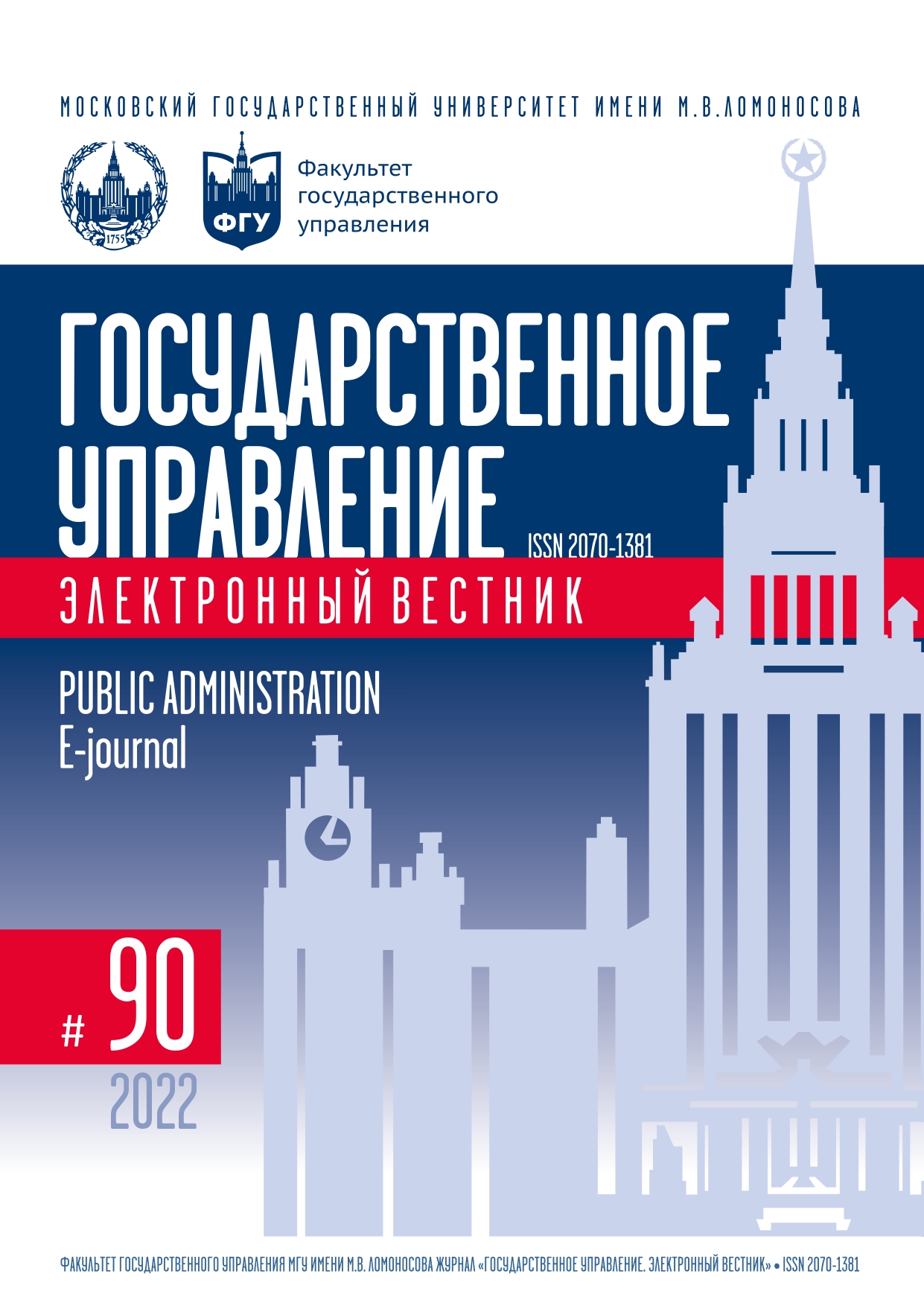Local Self-Government of China in the System of Mobilization Mechanisms to Counter COVID-19 (Case of Wuhan)
Keywords:
Local self-government, committees of urban residents, COVID-19, mobilization mechanisms, Wuhan, ChinaAbstract
The article shows the features of China’s mobilization mechanisms, highlighting the practices of local self-government in extreme conditions. Using the example of the city of Wuhan — the administrative center of Hubei Province, a major transport hub — the mobilization of local communities to fight the new coronavirus in the first half of 2020 is analysed. The territorial approach, situational analysis with the political and geographical localization of the research object (the Wuhan case) allow us to reveal the role of local government as an important part of the entire system of mobilization mechanisms in the fight against the new coronavirus. At the same time, the authors do not detach the analysis of urban events from studying the efforts of the whole country in the fight against COVID-19. The theory of securitization and the concept of “consultative authoritarianism” serve as the theoretical basis of the study. Positivist and realistic approaches to security cannot fully reveal the extent of the danger that the broad strata of society should realize. This weakens the mobilization of the population. In order to mobilize society to fight the danger, it is necessary to use information resources to influence people’s minds so that they understand the scope of the threat. This all is mostly relevant for such a threat as a dangerous virus. A powerful information “charge” is a component of the system of mobilization mechanisms, which fits into the framework of the securitization theory. The theory of “consultative authoritarianism” is revealed by the example of the emergency situation in Wuhan, where the state government interacted with the local “network” self-government, adjusted the content of social networks to prevent panic and ensure effective quarantine in Wuhan. All this made it possible for the state to prepare the conditions for vaccination and other measures in a successful resistance to COVID-19.
References
Ван Я., Капицын В. Территориальное управление и самоуправление в Китае // Самоуправление. 2013. № 4. С. 42–45.
Демчук А.Л., Капицын В.М., Каратеев А.Ю., Емельянова Н.Н., Дашкина И.В., Пашин М.М., Колесников С.И. Возможности количественного анализа взаимосвязи тяжести пандемии COVID-19 и институциональных характеристик стран мира // Acta Biomedica Scientifica. 2021. Т. 6. № 6–2. С. 133–144. DOI: https://doi.org/10.29413/ABS.2021-6.6-2.14.
Ерохина Л.Д., Чжан Хай Лунь. Трансформация социальной структуры городов Китая в условиях урбанизации // Общество: социология, психология, педагогика. 2018. № 2. С. 51–55. DOI: 10.24158/spp.2018.2.9.
Зайцев А.В. Гражданское общество и делиберативная демократия в Китае // Мир русскоговорящих стран. 2020. № 1. С. 35–46.
Кашин В.Б., Смирнова В.А., Аксенов И.В. Информационно-политическое измерение эпидемического кризиса COVID-19 в Китае // Международная аналитика. 2020. Т. 11. № 1. С. 27–41. DOI: https://doi.org/10.46272/2587-8476-2020-11-1-27-41.
Котельникова Т.В. Исследование территориальных общин в современной китайской науке // Вестник Читинского государственного ун-та. 2010. № 2(59). С. 141–148.
Huang Y., Smith Ch.J. China’s Response to Pandemics: From Inaction to Overreaction // Eurasian Geography and Economics. 2010. Vol. 51. Is. 2. P. 162–183. DOI: https://doi.org/10.2747/1539-7216.51.2.162.
Jue J. A Question of Human Rights or Human Left? The «People’s War against COVID-19» under the «Gridded Management» System in China // Journal of Contemporary China. 2021. DOI: https://doi.org/10.1080/10670564.2021.1985827.
Li S., Wang Y., Xue J., Zhao N., Zhu T. The Impact of COVID-19 Epidemic Declaration on Psychological Consequences: A Study on Active Weibo Users // International Journal of Environmental Research and Public Health. 2020. Vol. 17. Is. 6. DOI: https://doi.org/10.3390/ijerph17062032.
Liu Q., Luo D., Haase J.E., Guo Q., Wang X.Q., Liu S., Xia L., Liu Zh., Yang J., Yang B.X. The Experiences of HealthCare Providers during the COVID-19 Crisis in China: A Qualitative Study // The Lancet Global Health. 2020a. Vol. 8. Is. 6. P. e790–e798. DOI: 10.1016/S2214-109X(20)30204-7.
Liu Zh., An Yu., Wu K. China’s Mental Health Interventions During the COVID-19 Outbreak // Psychology in Russia: State of the Art. 2020b. Vol.13. Is.4. P. 183–190.
Pan J. Temporality Alignment: How WeChat Transforms Government Communication in Chinese Cities // Chinese Journal of Communication. 2020. Vol. 13. Is. 3. P. 241–257. DOI: https://doi.org/10.1080/17544750.2019.1679855.
Plantin Jean-Ch., de Seta G. WeChat as Infrastructure: The Techno-Nationalist Shaping of Chinese Digital Platforms // Chinese Journal of Communication. 2019. Vol. 12. Is. 3. P. 257–273. DOI: https://doi.org/10.1080/17544750.2019.1572633.
Qian Y., Hanser A. How did Wuhan Residents Cope with a 76-Day Lockdown? // Chinese Sociological Review. 2020. Vol.53. Is.2. P. 55–86. DOI: https://doi.org/10.1080/21620555.2020.1820319.
Ren X. Pandemic and Lockdown: A Territorial Approach to COVID-19 in China, Italy and the United States // Eurasian Geography and Economics. 2020. Vol. 61. Is. 4–5. P. 423–434. DOI: https://doi.org/10.1080/15387216.2020.1762103.
Tang B. China’s Housing Middle Class: Changing Urban Life in Gated Communities. London: Routledge, 2018.
Tang B. Grid Governance in China’s Urban Middle-Class Neighbourhoods // The China Quarterly. 2020. Vol. 241. P. 43–61. DOI: https://doi.org/10.1017/S0305741019000821.
Tang B., Xia F., Tang S., Bragazzi N.L., Li Q., Sun X., Liang J., Xiao Y., Wu J. The Effectiveness of Quarantine and Isolation Determine the Trend of the COVID-19 Epidemics in the Final Phase of the Current Outbreak in China // International Journal of Infectious Disease. 2020. Vol. 96. P. 636–647. DOI: https://doi.org/10.1016/j.ijid.2020.05.113.
Teets J.C. Let Many Civil Societies Bloom: The Rise of Consultative Authoritarianism in China // The China Quarterly. 2013. Vol. 213. P. 19–38. DOI: https://doi.org/10.1017/S0305741012001269.
Tu F. WeChat and Civil Society in China // Communication and the Public. 2016. Vol. 1. Is. 3. P. 343–350. DOI: https://doi.org/10.1177/2057047316667518.
Wang Zh. With the Rise of China, What’s New for Comparative Politics? // Chinese Political Science Review. 2016. Vol. 1. Is. 3. P. 506–521. DOI: 10.1007/s41111-016-0035-x.
Wolf M. Rethinking Urban Epidemiology: Natures, Networks and Materialities: Rethinking Urban Epidemiology // International Journal of Urban and Regional Research. 2016. Vol. 40. Is. 5. P. 958–982. DOI: https://doi.org/10.1111/1468-2427.12381.
Woodman S. Local Politics, Local Citizenship? Socialized Governance in Contemporary China // The China Quarterly. 2016. Vol. 226. P. 342–362. DOI: https://doi.org/10.1017/S0305741016000345.
Wu C., Shi Zh., Wilkes R., Wu J., Gong Zh., He N. et al. Chinese Citizen Satisfaction with Government Performance during COVID-19 // Journal of Contemporary China. 2021. Vol. 30. Is. 132. P. 930–944. DOI: https://doi.org/10.1080/10670564.2021.1893558.
Xia M. Social Capital and Rural Grassroots Governance in China // Journal of Current Chinese Affairs. 2011. Vol. 40. Is. 2. P. 135–163. DOI: https://doi.org/10.1177/186810261104000206.
Xú Y. Chéngxiāng shèqū jiànshè lǐlùn de zǒngtǐ gàishù. (Общий обзор теории строительства городских и сельских общин). Wǔhàn: Húběi kēxué jìzhōu qiūbān shè, 2008.
Yan P., Schroeder R. Variations in the Adoption and Use of Mobile Social Apps in Everyday Lives in Urban and Rural China // Mobile Media & Communication. 2020. Vol. 8. Is. 3. P. 318–341. DOI: https://doi.org/10.1177/2050157919884718.
Yang X., Peng L. Focusing on Health-Care Providers’ Experiences in the COVID-19 Crisis // The Lancet Global Health. 2020. Vol. 8. Is. 6. P. E740–E741. DOI: https://doi.org/10.1016/S2214-109X(20)30214-X.
Downloads
Published
Similar Articles
- Sergey M. Nikonorov, Anastasiia N. Kulikova, Floating Nuclear Power Plant as a Driver for the Sustainable Development of Arctic Cities (on the Example of Pevek) , Public Administration. E-journal (Russia): No. 107 (2024)
- Olga T. Ergunova, Nataliya E. Belyakova, Andrey G. Somov, Methodology of Building a Neural Network Architecture for Regulating Social and Labour Processes in BRICS Megacities , Public Administration. E-journal (Russia): No. 111 (2025)
- Oleg M. Roy, Accountability as an Object of Legal Assessment , Public Administration. E-journal (Russia): No. 108 (2025)
- Elena S. Daniliuk, Comparison of Local Government Bodies Competence in the Republic of Belarus with Indicators for Assessing Their Effectiveness , Public Administration. E-journal (Russia): No. 87 (2021)
- Roman V. Babeykin, Assessing the Efficiency of Regional Practices of Governance Centralizationin the Field of Urban Planning in Russia , Public Administration. E-journal (Russia): No. 106 (2024)
- Timur O. Tarba, Instruments of Interaction between State Corporations and Subjects of the Russian Federation , Public Administration. E-journal (Russia): No. 109 (2025)
- Olga I. Dolganova, Dmitry A. Kozyrev, Foreign Experience in Digitalization of Preventive Public Financial Control (on the Example of USA, China, Canada, India and Australia) , Public Administration. E-journal (Russia): No. 104 (2024)
- Elena I. Vasileva, Anastasia V. Orfonidii, Implementation of Smart City Project in Cities of Ural Federal District , Public Administration. E-journal (Russia): No. 94 (2022)
- Ekaterina A. Panova, Eugenia V. Andryushina, Russian Monotowns: Factors of Socio-Political Conflicts Extension , Public Administration. E-journal (Russia): No. 88 (2021)
- Irina V. Loguntsova, Alexandra S. Zaytseva, Branding of Russian Cities: Practice Review of Russian Federation Regional “Capitals” , Public Administration. E-journal (Russia): No. 103 (2024)
You may also start an advanced similarity search for this article.




